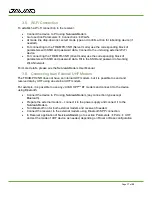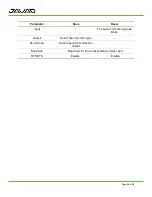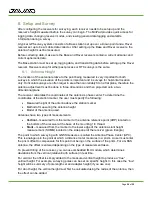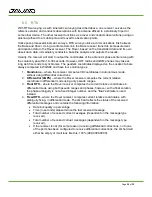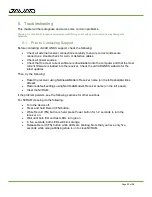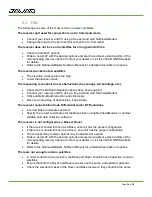
Page
19
of
35
5. RTK / Post-Processing Configuration
When configuring receivers for RTK surveying, use the following list to ensure the receivers are
properly set up:
•
Configure one receiver as an RTK Base station and the other receiver as an RTK Rover.
•
Configure the communication data link for transmitting and receiving corrections.
•
Set up the Base receiver over a known point to begin collecting static observation data
and transmitting corrections. Set up the Rover receiver to begin collecting RTK data.
When configuring receivers for post-processing surveying, use the following list to ensure the
receivers are properly set up:
•
Configure one receiver as a Rover.
•
Set up the Rover receiver to begin collecting measurements data.
•
Configure RTPK parameters and source for post-process surveying.
•
Apply RTPK calculations for the measurements made with the Rover.
5.1. RTK Setup for Base and Rover
The following Base and Rover configurations are recommended for the most common
applications. However, you can select configuration parameters as needed for your particular
jobsite.
Note: Do not make other changes without consulting the NetView&Modem Software Manual.
Parameter
Base
Rover
Implicit Message Output
Period
15 seconds 15 seconds
Evaluation Mask angle
15 degrees 15 degrees
File name prefix
Enter a unique ID, such as the last 3 digits of receiver’s serial
number. By default, the prefix is log
REC (FN) key mode
(starts/stops the data recording when FN button is used)
Select LED blink mode
switch for Static data
Select Occupation mode
switch (for RTK)
Initial dynamic mode
-
Select Dynamic (for trajectory
survey)
1. Connect the receiver and computer, start NetView&Modem and establish the connection
as described above.
2. Click
Receiver
>
Parameters
on the left panel.
3. In the
General
tab check antenna status of the parameter
Antenna Input
to be
Internal
(External antenna input is not available for TRIUMPH-3NR).
4. Open the
Log files
tab and then
TriPad
tab and set the following parameters, click
Apply
.













